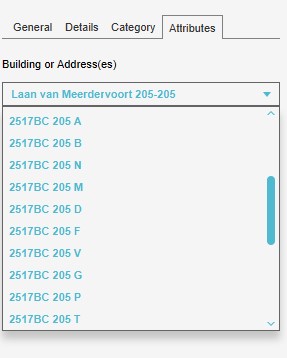Address
Address
An address is a specific reference to the whereabouts and location of a construction, given to it and registered by the municipality. The set up of addresses is built on the assumption that buildings are fixed
Addresses in the Tygron Platform
The Tygron Platform distinguishes Addresses as a discrete type of data separate from Constructions but strongly related. Any Construction can have 0 or more Addresses related to it. Each Address in turn can only be related to exactly one Construction.
When creating a new project in the Netherlands, addresses can be automatically generated based on the BAG and TOP10NL. These databases contain the data on both addresses and buildings. The Tygron Platform uses this data to assemble project-specific data of both Constructions and Addresses, relating them as appropriate.
Properties of addresses
Addresses have a number of properties. In the Editor, individual addresses can be accessed by selecting the Construction. The Addresses will be listed in the bottom panel.
Function information
Each address has information regarding the function at that address. Since Constructions can be used for multiple differing activities, for example having stores on the ground floor but housing units in the floors above, this allows for considerations within a single Construction for different activities and functions.
The function of the Address is a string of text, with differing functions for the same address separated by comma's. Note that the descriptions of the function of Addresses are distinctly different from the Tygron Platform's built-in Functions of Construction. The text describing the function of an Address is based directly on the BAG's records and is text only, whereas a Construction's Function is a separate datatype with multiple properties of its own.

Address information
Addresses primarily have properties related to identifying the address uniquely. These include:
- Zipcode
- Street
- Number
- Letter
- Addition
Address code
Addresses are uniquely identified by a combination of these properties. Such a combination is known as an Address Code, and is constructed as follows:
Zipcode + House Number + Letter + Addition
If any part is not relevant to a specific address (e.g. not every address has a Letter, or an Addition, or either), that part is omitted but the spaces which would otherwise separate the individual term may still be present.
Surface size
Each Address can also have a configured surface size, which is not strictly linked to the total surface size or floor size of the Construction. Deviation or other difference between a Construction's floorsize and the sum of the surface sizes of its related Addresses may be attributed to additional underground floors, or common areas in the Construction which are not otherwise part of a specific Address. Examples include atriums, stairways/elevators, and other corridors.
Attributes

Addresses may also be further enriched via Attributes, allowing arbitrary data to be assigned to them.
Template:Construction attributes
Attributes of Addresses can be accessed through the Attributes overview of their related Construction, where a dropdown allows for a switch between displaying the Attributes of the Construction itself, or the Attributes of a specific Address.
In the attributes of a building, an overview of the different addresses can be found. The different addresses registered to a construction by the Tygron Platform are still adjustable after the generation of the 3D model. The funciton type of an address can be defined using string format, this means that multiple function types can be registrated to one building. For example an address can contain both a residential home and an office.
Network Wizard
When generating a networks using the network wizard each separeate address will have each own load, so it's possible for a construction to hold multiple load points. These load points will eventually determine the value of the nodes, which are connected to a network.